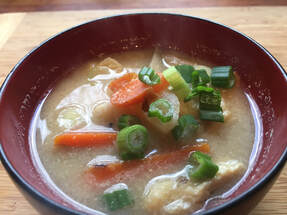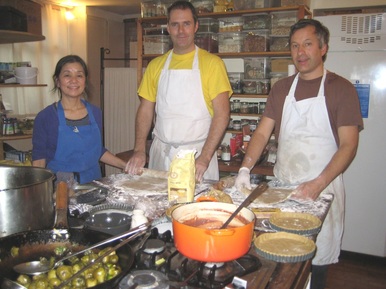When leaves start to fall and the weather gets chilly, we layer on more clothes and enjoy more slow cooking such
as stews or baking. When we turn on the
heater, it is time to enjoy more root vegetables.
We live such busy lives. Cooking can ground us, nurture us, and give us a great sense of serenity. Home cooking is the foundation of well-being; our life.
We live such busy lives. Cooking can ground us, nurture us, and give us a great sense of serenity. Home cooking is the foundation of well-being; our life.
Kombu-Dashi
|
Kombu Stock is made with kombu seaweed also known as kelp. It is very rich in minerals from the ocean. Japanese cooking can use Kombu-Dashi for many different dishes, not just soups. It is very practical to keep Kombu-Dashi in the fridge and use as needed. You can also just add kombu directly to soup or other dishes. As you can see when you place kombu in the water, you are recreating the ocean.
Instructions:
Can add a few pieces of dried shiitake (to make Kombu-and-Shiitake Dashi) |
Hearty Root Vegetable Miso Soup
 Vegetable Miso Soup.
Miso is a fermented soybean paste (other varieties are made from barley, chick peas, or brown rice). The darker the color, the stronger the taste.
Vegetable Miso Soup.
Miso is a fermented soybean paste (other varieties are made from barley, chick peas, or brown rice). The darker the color, the stronger the taste.
Studies show that having bowls of Miso soup slows down aging. The healthy bacteria of the
Miso helps to maintain our intestinal health. When our gut is healthy, we don't catch colds.
Use seasonal vegetables to make seasonal Miso soup.
Instructions for a Fall/Winter Soup (serves 4):
Please use organic vegetables if you can. When you wash vegetables, use a vegetable brush.
No need to peel the skin of the carrot (this is WHOLE FOODS cooking). Use whole as much as possible.
Peel the onion and slice thin.
Cut carrot, burdock root, and daikon (or turnip) on the diagonal into small rounds.
Saute onion and burdock, then add rest of the vegetables with a very little sesame oil in the skillet.
Place vegetables in a pot, add water and kombu piece, or use Kombu-Dashi.
Boil until vegetables get soft.
Turn off the heat. Add Miso and serve with chopped green onion.
Note: Do not let the soup boil after adding Miso to keep the helpful bacteria active.
Miso helps to maintain our intestinal health. When our gut is healthy, we don't catch colds.
Use seasonal vegetables to make seasonal Miso soup.
Instructions for a Fall/Winter Soup (serves 4):
Please use organic vegetables if you can. When you wash vegetables, use a vegetable brush.
No need to peel the skin of the carrot (this is WHOLE FOODS cooking). Use whole as much as possible.
- 1/2 onion, sliced thin
- 1 carrot
- 1/4 Kabocha squash (any squash)
- burdock root (3-4 inches)
- daikon radish or turnip (1-2 inches)
- 6 cups of spring or filtered water (or Kombu-Dashi)
- 1 piece of Kombu (1-2 inches)
- dried shiitake mushrooms (2-3 pieces)
- 3-4 tablespoons of Miso (can be a mix of barley Miso and chick pea Miso)
- chopped green onion for serving
Peel the onion and slice thin.
Cut carrot, burdock root, and daikon (or turnip) on the diagonal into small rounds.
Saute onion and burdock, then add rest of the vegetables with a very little sesame oil in the skillet.
Place vegetables in a pot, add water and kombu piece, or use Kombu-Dashi.
Boil until vegetables get soft.
Turn off the heat. Add Miso and serve with chopped green onion.
Note: Do not let the soup boil after adding Miso to keep the helpful bacteria active.



